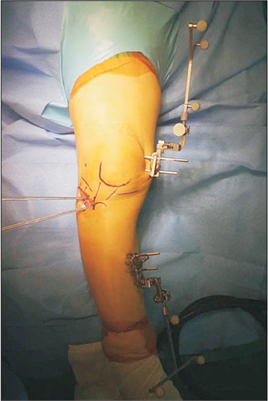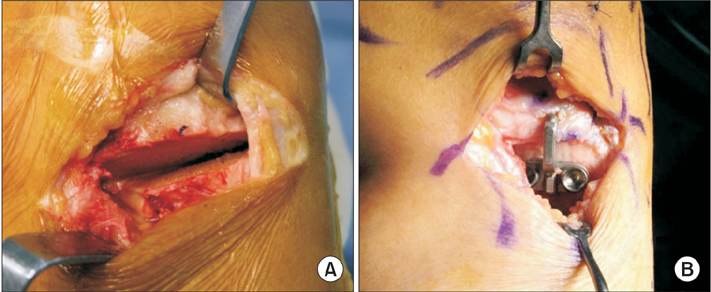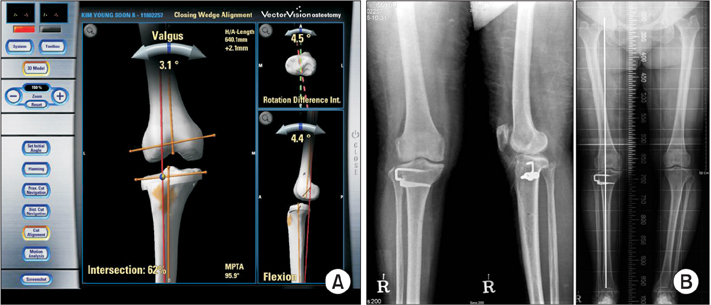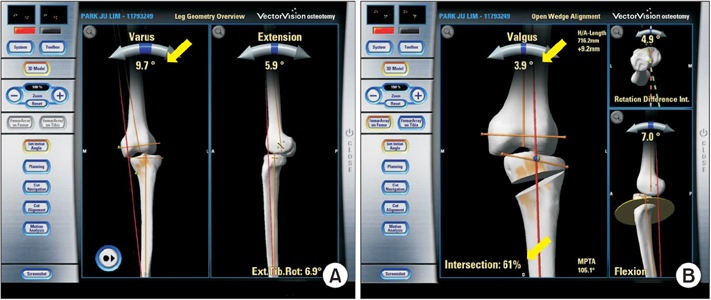Clin Orthop Surg.
2016 Dec;8(4):349-357. 10.4055/cios.2016.8.4.349.
Computer-Assisted Navigation in High Tibial Osteotomy
- Affiliations
-
- 1Department of Orthopaedic Surgery, Kyung Hee University College of Medicine, Seoul, Korea. tesstore@empas.com
- KMID: 2412315
- DOI: http://doi.org/10.4055/cios.2016.8.4.349
Abstract
- Computer-assisted navigation is used to improve the accuracy and precision of correction angles during high tibial osteotomy. Most studies have reported that this technique reduces the outliers of coronal alignment and unintended changes in the tibial posterior slope angle. However, more sophisticated studies are necessary to determine whether the technique will improve the clinical results and long-term survival rates. Knowledge of the navigation technology, surgical techniques and potential pitfalls, the clinical results of previous studies, and understanding of the advantages and limitations of the computer-assisted navigation are crucial to successful application of this new technique in high tibial osteotomy. Herein, we review the evidence concerning this technique from previous studies.
Keyword
MeSH Terms
Figure
Reference
-
1. Picardo NE, Khan W, Johnstone D. Computer-assisted navigation in high tibial osteotomy: a systematic review of the literature. Open Orthop J. 2012; 6:305–312.
Article2. Thompson SR, Zabtia N, Weening B, Zalzal P. Arthroscopic and computer-assisted high tibial osteotomy using standard total knee arthroplasty navigation software. Arthrosc Tech. 2013; 2(2):e161–e166.
Article3. Sharma L, Chmiel JS, Almagor O, et al. The role of varus and valgus alignment in the initial development of knee cartilage damage by MRI: the MOST study. Ann Rheum Dis. 2013; 72(2):235–240.
Article4. Lutzner J, Gross AF, Gunther KP, Kirschner S. Precision of navigated and conventional open-wedge high tibial osteotomy in a cadaver study. Eur J Med Res. 2010; 15(3):117–120.
Article5. Miniaci A, Ballmer FT, Ballmer PM, Jakob RP. Proximal tibial osteotomy: a new fixation device. Clin Orthop Relat Res. 1989; (246):250–259.6. Noyes FR, Barber SD, Simon R. High tibial osteotomy and ligament reconstruction in varus angulated, anterior cruciate ligament-deficient knees: a two- to seven-year follow-up study. Am J Sports Med. 1993; 21(1):2–12.
Article7. Hankemeier S, Hufner T, Wang G, et al. Navigated open-wedge high tibial osteotomy: advantages and disadvantages compared to the conventional technique in a cadaver study. Knee Surg Sports Traumatol Arthrosc. 2006; 14(10):917–921.
Article8. Iorio R, Pagnottelli M, Vadala A, et al. Open-wedge high tibial osteotomy: comparison between manual and computer-assisted techniques. Knee Surg Sports Traumatol Arthrosc. 2013; 21(1):113–119.
Article9. Noyes FR, Goebel SX, West J. Opening wedge tibial osteotomy: the 3-triangle method to correct axial alignment and tibial slope. Am J Sports Med. 2005; 33(3):378–387.
Article10. Young SW, Safran MR, Clatworthy M. Applications of computer navigation in sports medicine knee surgery: an evidence-based review. Curr Rev Musculoskelet Med. 2013; 6(2):150–157.
Article11. Bae DK, Song SJ. Computer assisted navigation in knee arthroplasty. Clin Orthop Surg. 2011; 3(4):259–267.
Article12. Bae DK, Song SJ, Yoon KH. Closed-wedge high tibial osteotomy using computer-assisted surgery compared to the conventional technique. J Bone Joint Surg Br. 2009; 91(9):1164–1171.
Article13. Song EK, Seon JK, Park SJ. How to avoid unintended increase of posterior slope in navigation-assisted open-wedge high tibial osteotomy. Orthopedics. 2007; 30:10 Suppl. S127–S131.14. Yim JH, Seon JK, Song EK. Posterior tibial slope in medial opening-wedge high tibial osteotomy: 2-D versus 3-D navigation. Orthopedics. 2012; 35:10 Suppl. 60–63.
Article15. Khadem R, Yeh CC, Sadeghi-Tehrani M, et al. Comparative tracking error analysis of five different optical tracking systems. Comput Aided Surg. 2000; 5(2):98–107.
Article16. Gebhard F, Krettek C, Hufner T, et al. Reliability of computer-assisted surgery as an intraoperative ruler in navigated high tibial osteotomy. Arch Orthop Trauma Surg. 2011; 131(3):297–302.
Article17. Keppler P, Gebhard F, Grutzner PA, et al. Computer aided high tibial open wedge osteotomy. Injury. 2004; 35:Suppl 1. S-A68–S-A78.
Article18. Kendoff DO, Fragomen AT, Pearle AD, Citak M, Rozbruch SR. Computer navigation and fixator-assisted femoral osteotomy for correction of malunion after periprosthetic femur fracture. J Arthroplasty. 2010; 25(2):333.e13–333.e19.
Article19. Yaffe MA, Koo SS, Stulberg SD. Radiographic and navigation measurements of TKA limb alignment do not correlate. Clin Orthop Relat Res. 2008; 466(11):2736–2744.
Article20. Kyung BS, Kim JG, Jang KM, et al. Are navigation systems accurate enough to predict the correction angle during high tibial osteotomy? Comparison of navigation systems with 3-dimensional computed tomography and standing radiographs. Am J Sports Med. 2013; 41(10):2368–2374.
Article21. Bae DK, Park CH, Kim EJ, Song SJ. Medial cortical fractures in computer-assisted closing-wedge high tibial osteotomy. Knee. 2016; 23(2):295–299.
Article22. Goleski P, Warkentine B, Lo D, Gyuricza C, Kendoff D, Pearle AD. Reliability of navigated lower limb alignment in high tibial osteotomies. Am J Sports Med. 2008; 36(11):2179–2186.
Article23. Yamamoto Y, Ishibashi Y, Tsuda E, Tsukada H, Kimura Y, Toh S. Validation of computer-assisted open-wedge high tibial osteotomy using three-dimensional navigation. Orthopedics. 2008; 31:10 Suppl 1. 68–71.24. Saragaglia D, Chedal-Bornu B. Computer-assisted osteotomy for valgus knees: medium-term results of 29 cases. Orthop Traumatol Surg Res. 2014; 100(5):527–530.
Article25. Ribeiro CH, Severino NR, Moraes de Barros Fucs PM. Opening wedge high tibial osteotomy: navigation system compared to the conventional technique in a controlled clinical study. Int Orthop. 2014; 38(8):1627–1631.
Article26. Akamatsu Y, Mitsugi N, Mochida Y, et al. Navigated opening wedge high tibial osteotomy improves intraoperative correction angle compared with conventional method. Knee Surg Sports Traumatol Arthrosc. 2012; 20(3):586–593.
Article27. Kim SJ, Koh YG, Chun YM, Kim YC, Park YS, Sung CH. Medial opening wedge high-tibial osteotomy using a kinematic navigation system versus a conventional method: a 1-year retrospective, comparative study. Knee Surg Sports Traumatol Arthrosc. 2009; 17(2):128–134.
Article28. Maurer F, Wassmer G. High tibial osteotomy: does navigation improve results? Orthopedics. 2006; 29:10 Suppl. S130–S132.29. Saragaglia D, Roberts J. Navigated osteotomies around the knee in 170 patients with osteoarthritis secondary to genu varum. Orthopedics. 2005; 28:10 Suppl. s1269–s1274.
Article30. Iorio R, Vadala A, Giannetti S, et al. Computer-assisted high tibial osteotomy: preliminary results. Orthopedics. 2010; 33:10 Suppl. 82–86.
Article31. Na YG, Eom SH, Kim SJ, Chang MJ, Kim TK. The use of navigation in medial opening wedge high tibial osteotomy can improve tibial slope maintenance and reduce radiation exposure. Int Orthop. 2016; 40(3):499–507.
Article32. Miller BS, Downie B, McDonough EB, Wojtys EM. Complications after medial opening wedge high tibial osteotomy. Arthroscopy. 2009; 25(6):639–646.
Article33. Nelissen EM, van Langelaan EJ, Nelissen RG. Stability of medial opening wedge high tibial osteotomy: a failure analysis. Int Orthop. 2010; 34(2):217–223.
Article34. Takeuchi R, Umemoto Y, Aratake M, et al. A mid term comparison of open wedge high tibial osteotomy vs unicompartmental knee arthroplasty for medial compartment osteoarthritis of the knee. J Orthop Surg Res. 2010; 5(1):65.
Article35. van Raaij TM, Brouwer RW, de Vlieger R, Reijman M, Verhaar JA. Opposite cortical fracture in high tibial osteotomy: lateral closing compared to the medial opening-wedge technique. Acta Orthop. 2008; 79(4):508–514.
Article36. Kessler OC, Jacob HA, Romero J. Avoidance of medial cortical fracture in high tibial osteotomy: improved technique. Clin Orthop Relat Res. 2002; (395):180–185.
Article37. Saragaglia D, Mercier N, Colle PE. Computer-assisted osteotomies for genu varum deformity: which osteotomy for which varus? Int Orthop. 2010; 34(2):185–190.
Article38. Goradia VK. Computer-assisted and robotic surgery in orthopedics: where we are in 2014. Sports Med Arthrosc. 2014; 22(4):202–205.39. Citak M, Kendoff D, O'Loughlin PF, Pearle AD. Heterotopic ossification post navigated high tibial osteotomy. Knee Surg Sports Traumatol Arthrosc. 2009; 17(4):352–355.
Article
- Full Text Links
- Actions
-
Cited
- CITED
-
- Close
- Share
- Similar articles
-
- Navigation versus Radiographic Measurements in the Open-Wedge High Tibial Osteotomy using Computer Assisted Surgery (CAS)
- Navigation Guided Open Wedge High Tibial Osteotomy
- A Comparative Study of the Navigated and Radiographic Measurements in Open and Closed Wedge High Tibial Osteotomy with Computer Assisted Surgery
- Comparison of Mechanical Axis and Dynamic Range Assessed with Weight Bearing Radiographs and Navigation System in Closed Wedge High Tibial Osteotomy
- Computer Assisted Knee Surgery Using Navigation System






